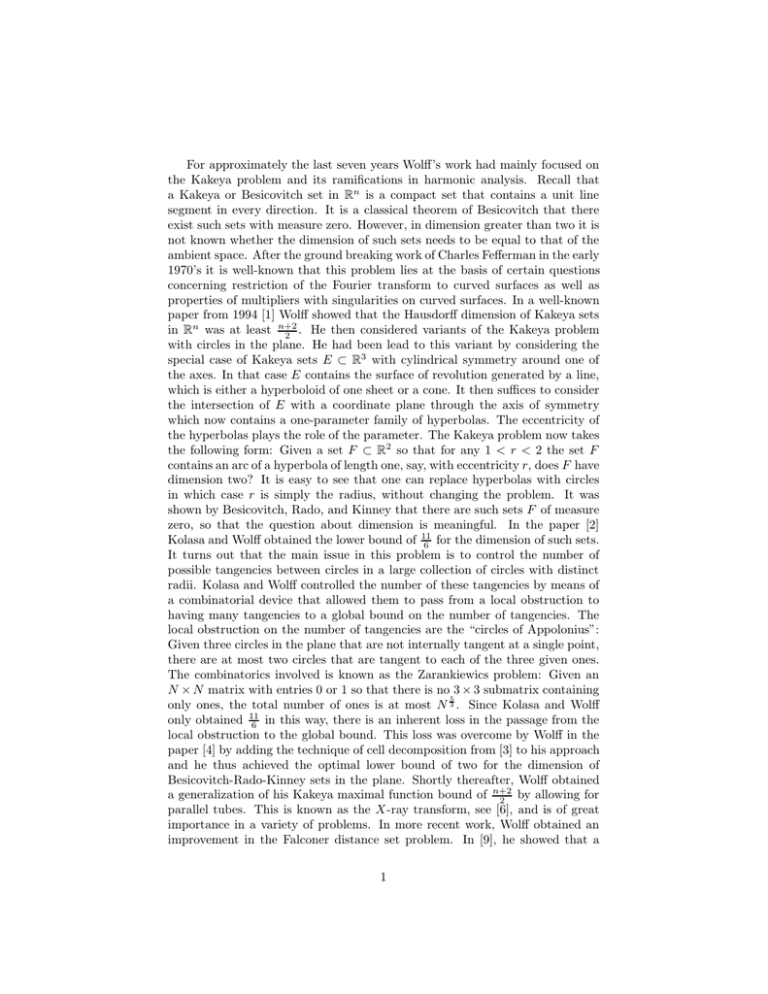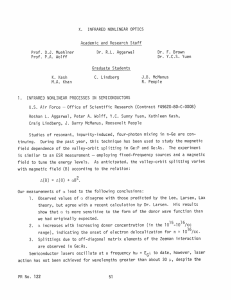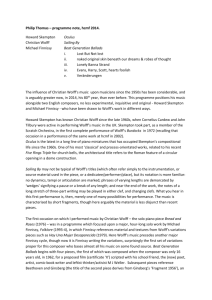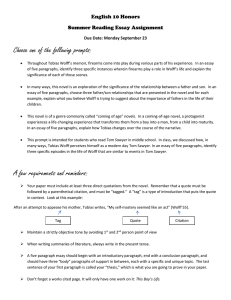For approximately the last seven years Wolff’s work had mainly... the Kakeya problem and its ramifications in harmonic analysis. Recall...
advertisement

For approximately the last seven years Wolff’s work had mainly focused on the Kakeya problem and its ramifications in harmonic analysis. Recall that a Kakeya or Besicovitch set in Rn is a compact set that contains a unit line segment in every direction. It is a classical theorem of Besicovitch that there exist such sets with measure zero. However, in dimension greater than two it is not known whether the dimension of such sets needs to be equal to that of the ambient space. After the ground breaking work of Charles Fefferman in the early 1970’s it is well-known that this problem lies at the basis of certain questions concerning restriction of the Fourier transform to curved surfaces as well as properties of multipliers with singularities on curved surfaces. In a well-known paper from 1994 [1] Wolff showed that the Hausdorff dimension of Kakeya sets in Rn was at least n+2 2 . He then considered variants of the Kakeya problem with circles in the plane. He had been lead to this variant by considering the special case of Kakeya sets E ⊂ R3 with cylindrical symmetry around one of the axes. In that case E contains the surface of revolution generated by a line, which is either a hyperboloid of one sheet or a cone. It then suffices to consider the intersection of E with a coordinate plane through the axis of symmetry which now contains a one-parameter family of hyperbolas. The eccentricity of the hyperbolas plays the role of the parameter. The Kakeya problem now takes the following form: Given a set F ⊂ R2 so that for any 1 < r < 2 the set F contains an arc of a hyperbola of length one, say, with eccentricity r, does F have dimension two? It is easy to see that one can replace hyperbolas with circles in which case r is simply the radius, without changing the problem. It was shown by Besicovitch, Rado, and Kinney that there are such sets F of measure zero, so that the question about dimension is meaningful. In the paper [2] Kolasa and Wolff obtained the lower bound of 11 6 for the dimension of such sets. It turns out that the main issue in this problem is to control the number of possible tangencies between circles in a large collection of circles with distinct radii. Kolasa and Wolff controlled the number of these tangencies by means of a combinatorial device that allowed them to pass from a local obstruction to having many tangencies to a global bound on the number of tangencies. The local obstruction on the number of tangencies are the “circles of Appolonius”: Given three circles in the plane that are not internally tangent at a single point, there are at most two circles that are tangent to each of the three given ones. The combinatorics involved is known as the Zarankiewics problem: Given an N × N matrix with entries 0 or 1 so that there is no 3 × 3 submatrix containing 5 only ones, the total number of ones is at most N 3 . Since Kolasa and Wolff only obtained 11 6 in this way, there is an inherent loss in the passage from the local obstruction to the global bound. This loss was overcome by Wolff in the paper [4] by adding the technique of cell decomposition from [3] to his approach and he thus achieved the optimal lower bound of two for the dimension of Besicovitch-Rado-Kinney sets in the plane. Shortly thereafter, Wolff obtained a generalization of his Kakeya maximal function bound of n+2 2 by allowing for parallel tubes. This is known as the X-ray transform, see [6], and is of great importance in a variety of problems. In more recent work, Wolff obtained an improvement in the Falconer distance set problem. In [9], he showed that a 1 set E ⊂ R2 of dimension bigger than 43 has a distance set of positive length. Jean Bourgain had previously shown that sets with dimension bigger than 13 9 have this property. It is conjectured that the bound of 43 can be lowered even further. He accomplished this by establishing the best possible decay rate on circular means of Fourier transforms of measures, a problem posed by Mattila. This latter result motivated the recent important development [10], where the sharp restriction bound of the Fourier transform to the cone in R4 is obtained. This is the first example of a surface with two nonvanishing principal curvatures where a sharp restriction bound on the Fourier transform is known. Another such example is the sphere in R3 , where the restriction conjecture due to Elias Stein is open. It is known that the restriction conjecture for the sphere implies the Kakeya conjecture, see for example [7]. Finally, Wolff combined the methods from [4] and [10] to obtain a sharp local smoothing bound for the wave equation in a certain range of exponents, see [11]. Concurrently with his main program that we just outlined, Wolff was applying harmonic analysis techniques to other areas, like mathematical physics. In [5] Shubin, Vakilian, and Wolff studied the Anderson Bernoulli model on the line by means of some refined uncertainty principle ideas. It is well-known that under suitable conditions on sets E ⊂ Rn and F ⊂ Rn there is a constant C kf kL2(Rn ) ≤ C(kf kL2 (E c ) + kfˆkL2 (F c ) ) ∀ f ∈ L2 (Rn ). More precisely, Amrein and Berthier showed that this holds of E and F have finite measure. Also, a theorem of Logvinenko and Sereda states that it holds if F is the unit ball, say, and E is a set that is sufficiently thick in the sense that for some R and α > 0 |E ∩ B(x, R)| > α|B(x, R)| ∀ x ∈ Rn . A new instance of this fact was used in [5] to simplify the approach of Campanino, Klein, Martinelli, and Perez, which is based on the supersymmetric replica method, and thus extend it to the case of Bernoulli potentials. Moreover, they gave an alternative proof of Le Page’s theorem on Hölder continuity of the integrated density of states. In doing so they were able to show that the Hölder exponent stays bounded away from zero as the disorder goes to zero, at least away from the band edges. After the seminal work of Fürstenberg on products of random matrices it is natural to study the Anderson model on the line by means of the invariant measure of the Schrödinger cocycle that it gives rise to. Motivated by this connection, Wolff used the methods from [5] to obtain estimates for spectral gaps of certain representations of semi simple Lie groups, see [8]. Very recently, Wolff returned to the Anderson model. With Klopp he obtained novel estimates for Lifshitz tails at the band edges for the integrated density of states in the random model on R2 , see [12]. This used delicate estimates on the norm of oscillatory integral operators with nonconstant analytic phases obtained by Phong and Stein. Finally, in [13] it is shown that the discrete random model with disorder λ on Z2 has the property that a.s. most eigen 2 functions have Fourier transforms localized to annuli of thickness λ2− for any > 0. By the uncertainty principle this then implies that the localization length of most eigen functions is at least λ−2+ . 3 Bibliography [1] Wolff, Thomas An improved bound for Kakeya type maximal functions. Rev. Mat. Iberoamericana 11 (1995), no. 3, 651–674. [2] Kolasa, Lawrence; Wolff, Thomas On some variants of the Kakeya problem. Pacific J. Math. 190 (1999), no. 1, 111–154. [3] Clarkson, Kenneth L.; Edelsbrunner, Herbert; Guibas, Leonidas J.; Sharir, Micha; Welzl, Emo Combinatorial complexity bounds for arrangements of curves and spheres. Discrete Comput. Geom. 5 (1990), no. 2, 99–160. [4] Wolff, Thomas A Kakeya-type problem for circles. Amer. J. Math. 119 (1997), no. 5, 985–1026. [5] Shubin, C.; Vakilian, R.; Wolff, T. Some harmonic analysis questions suggested by Anderson-Bernoulli models. Geom. Funct. Anal. 8 (1998), no. 5, 932–964. [6] Wolff, Thomas A mixed norm estimate for the X-ray transform. Rev. Mat. Iberoamericana 14 (1998), no. 3, 561–600. [7] Wolff, Thomas Recent work connected with the Kakeya problem. Prospects in mathematics (Princeton, NJ, 1996), 129–162, Amer. Math. Soc., Providence, RI, 1999. [8] Wolff, Thomas A general spectral gap property for measures. unpublished manuscript. [9] Wolff, Thomas Decay of circular means of Fourier transforms of measures. Internat. Math. Res. Notices 1999, no. 10, 547–567. [10] Wolff, Thomas A sharp bilinear cone restriction estimate. To appear in Annals of Mathematics. [11] Wolff, Thomas Local smoothing type estimates on Lp for large p. To appear in Geometric and Functional Analysis [12] Klopp, F., Wolff, T. Internal Lifshitz tails for random Schrödinger operators. preprint, 2000. 4 [13] Schlag, W., Shubin, C., Wolff, T. Frequency concentration and localization lengths for the Anderson model at small disorders. To appear in Journal d’analyse math., preprint 2000. 5



